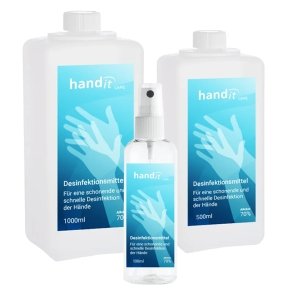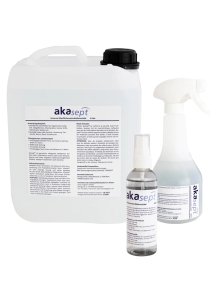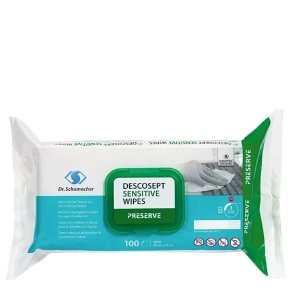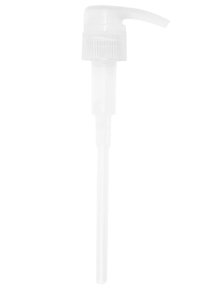Disinfectants in healthcare
The use of disinfectants in doctors' surgeries, hospitals, as well as old people's homes and nursing homes is unthinkable without them. The active substances they contain kill microorganisms such as bacteria, bacterial spores, fungi and viruses on surfaces or inhibit their growth. In this way, they prevent the transmission of most pathogens. As a result, the elderly and people with a weakened immune system can be effectively protected against dangerous infection. Compliance with hygiene measures is mandatory in public facilities and medical institutions.
Spectrum of action
Disinfectants have the task of inactivating or killing microorganisms that can cause diseases or infections. In contrast to sterilization, this only affects a specific type of germ and not all microbiological organisms. Therefore, for optimal effect, the following exposure time is recommended for each group of pathogens:
- against noro-, corona-, influenza viruses (virucidal) 30 seconds
- against standard bacteria (bactericidal) 30 seconds
- against yeast fungi (fungicidal) 30 seconds
- against mycobacteria (mycobactericidal) 60 seconds
Hand disinfection
Disinfecting hands kills germs on the hands. Using a disinfectant is about 100 times more effective than cleaning with water. Because approx. 80% of all germs are transmitted via the hands, hand hygiene plays a particularly important role in infection prophylaxis. With hygienic hand disinfection, an interruption of infection chains is achieved. The risk of infection is particularly high in high-contact and high-touch occupations. Hand disinfection is a legal requirement in the healthcare and catering sectors. It serves the purpose of self-protection and minimizes the risk to others. An alcohol content of over 70% ensures that all viruses and bacteria die off. There are also disinfection wipes, which are soaked with an alcohol solution and allow a particularly simple and quick hand disinfection.
Surface disinfection
Surface disinfection refers to the killing of germs on inanimate surfaces and objects. Pathogens can survive on surfaces for up to several months. From there, they can be spread, for example, via hands or dust particles. This is why surface disinfection is an important precautionary measure. Microorganisms are particularly numerous on surfaces with which many people come into contact. These are toilets, bathrooms, bathroom fittings, door handles, handrails, work surfaces, keyboards, floors, etc. Via surfaces and objects contaminated with germs, germs are indirectly transmitted to other people via hands and mucous membranes.
Application of disinfectants
For a thorough hygienic hand disinfection, about 3 ml of disinfectant liquid is required. The hands should remain moist during the exposure time of 30 seconds (or 60 seconds for mycobacteria). It is recommended to disinfect the hands after a trip by public transport or a visit to friends and relatives. In any case, you should avoid bringing germs home. In public places and in the office it is quite reasonable to disinfect the hands properly several times a day. 5 times a day is considered a healthy guideline. Hand disinfection must be done correctly to achieve the best results. The following steps should be followed:
- Apply disinfectant to one palm
- rub palm on palm
- rub right palm over left back of hand and left palm over right back of hand
- rub palm on palm with fingers interlocked and spread
- rub outside of fingers on opposite palms with fingers interlocked
- rub right and left thumbs
- rub closed fingertips into right and left palm
Manufacturer
For the production of our hand and surface disinfectants we trust in the long lasting cooperation with the company Novapura AG. Together we were able to ensure the Swiss quality standard and develop and optimize the in-house products Hand-it Care® and Akasept®.
In addition, we sell the hand disinfectant Sterillium® from the German manufacturer BODE. We also carry the aromatic disinfectant from Colosé in our range. The hand disinfectant can be ordered in 3 different sizes.
BAG-listed
Our disinfectants available online have all been tested by the BAG and have proven to be effective against bacteria, yeasts and enveloped viruses. An overview (disinfectant list) of the tested products can be found on the BAG site. According to the BAG, the surface disinfectants and skin disinfectants are suitable for the following areas of application:
- Hands
- surfaces in hospitals, nursing homes, laboratories and industry
- in companies in the food sector
Customers
Our disinfectants offer a very high quality standard. Our main customers include institutions that have to meet strict hygiene requirements. These include hospitals, federal government facilities, nursing homes, etc. The ethanol content of 70% effectively prevents the reproduction of pathogens.
Hazard statements
Disinfectants are highly flammable. Vapor may cause drowsiness and dizziness. In case of contact with eyes, eyes should be immediately flushed with water for several minutes. Disinfectants should be kept out of the reach of children. Improper use may lead to resistance of the microorganisms to be controlled. Excessive hand washing prior to disinfection is considered critical because the natural protective film of the skin is reduced and frequent use of disinfectants can cause irritation and discomfort. In addition, improper handling of disinfectants and in combination with other chemicals can produce unpleasant-smelling gases that are hazardous to health. A non-biodegradable disinfectant can impair the purification of wastewater by disrupting the interaction of bacteria.
Disposal
The shelf life of disinfectants is approximately 2 years if stored correctly. The expiration date can be seen on the back of the label. Expired disinfectants must be disposed of at a designated hazardous waste collection point to avoid contaminating wastewater.




